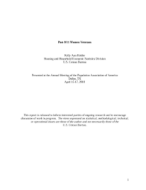Post-9/11 Women Veterans
Post-9/11 Women Veterans
Abstract
The role of women in the U.S. military has expanded greatly since the inception of the All-Volunteer Force (AVF) in 1973. Significant changes in legislation and policy in the early 1990s opened up occupational opportunities for active-duty women. According to Department of Defense data, over 80 percent of the services’ career positions are now open to women (GAO 1999). These changes allowed them to fly combat aircraft, serve on combat ships, and serve in combat-related occupations.
In addition to these policy changes, the nature of the wars in Iraq and Afghanistan has redefined the experience of women serving in the Armed Forces. The Persian Gulf War of 1991 saw what was then the largest deployment of women in U.S. military history, with approximately 41,000 women deployed to the region (GAO 1999). Since 2002, an unprecedented 155,000 women have been deployed to Iraq and Afghanistan (PBS.org). As these conflicts have grown longer and the need for soldiers has increased, the rules governing which jobs can be performed by women in the military have changed to meet these needs (PBS.org).
Today’s military women represent a generational shift. They no longer face the same challenges as their predecessors. Not only is the representation of women in the AVF increasing, but the demographics of these women are also changing. Military women are more likely to be members of a racial minority than military men (DoD 2005). They are less likely to be married than their male counterparts. Servicewomen are increasingly being assigned to more “non-traditional” jobs.
- Presentation [PPT - 1M]
- Poster [PDF - 679k]
- Detailed Tables [XLS - 64k]




